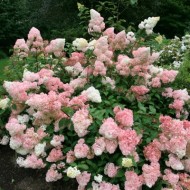We grow unpretentious panicle hydrangea "Phantom" in the country
Content
Description and characteristics of the variety
The biological name of this hydrangea is Hydrangea paniculata Phantom. The plant is distinguished by a significant size of the bush, it can reach a height of 2 m, expanding in breadth by 2–2.5 m. The shape depends on pruning, you can form a stem or grow a shrub. The branches are powerful, easily hold numerous inflorescences, giving the bush a very vivid description.
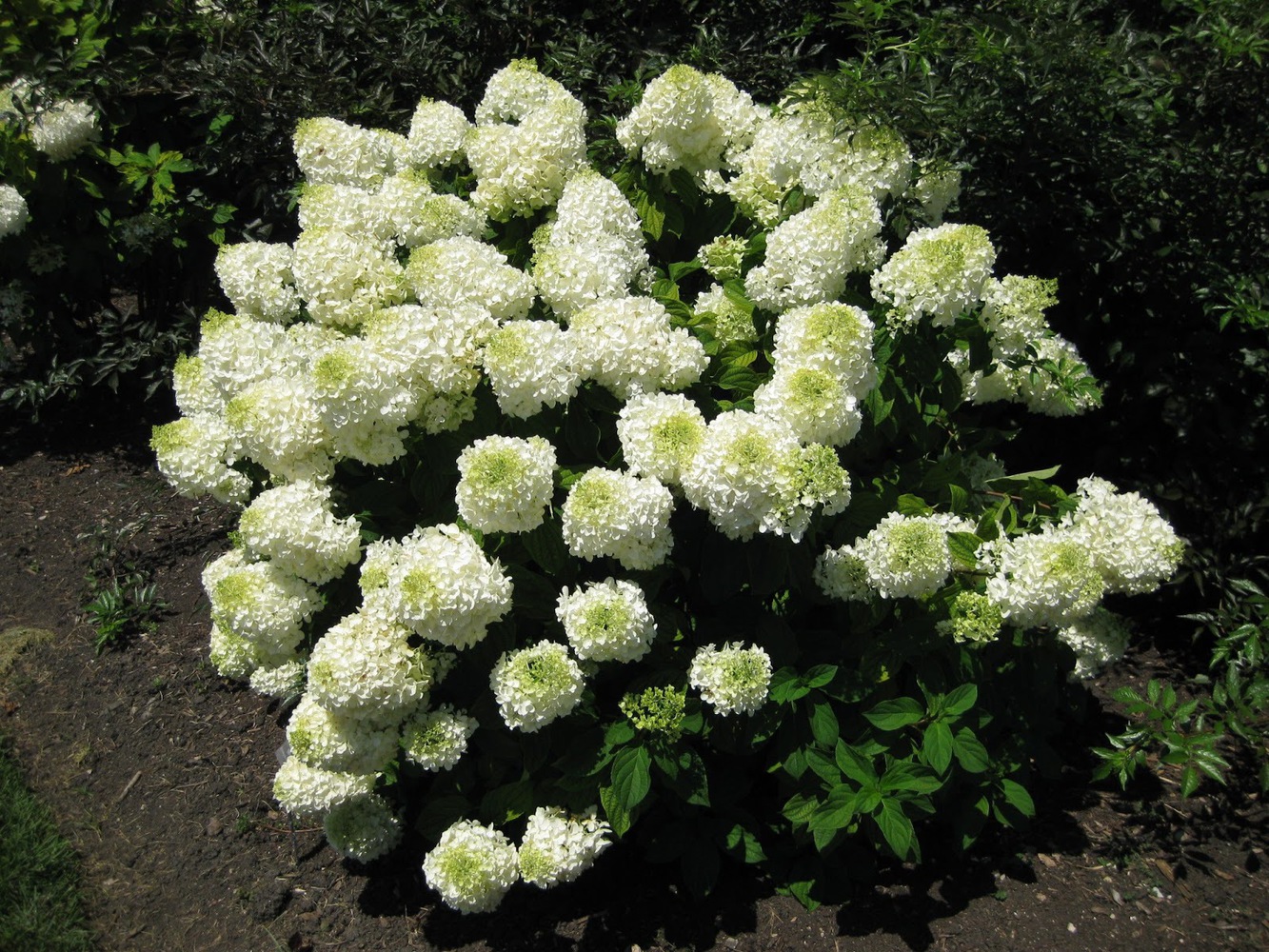
The panicle hydrangea begins to bloom at the age of 4–5 years. Bloom is abundant and lush, from late June to mid-October. Inflorescences are heavy, pyramidal, 25–30 cm long, interesting because they change color during the season. At first, the flowers are white with a greenish top, then they become creamy, and towards the end of flowering they acquire a pinkish tint.
Video "Features of growing hydrangea Phantom"
This video tells how the planting and caring for an ornamental shrub takes place.
Planting conditions and process
Having set out to grow a hydrangea on the site, one should take into account the peculiarities of planting and the requirements of the plant for the soil.
When to plant
Planting dates depend on the climate of a particular region. In the south, where there is no severe frost in winter, the bushes can be planted in the fall. In temperate and cold climates, it is best to plant in the spring, when the ground warms up well, around April-May.
Preparation of soil and planting material
The key to planting seedlings is the choice of location. Hydrangeas love light, but not bright and scorching, but diffused. Strong winds are also harmful for them, so you need to choose a slightly shaded area that is illuminated by the sun only in the morning. It is good to plant shrubs along fences or walls - they will provide protection from the wind.
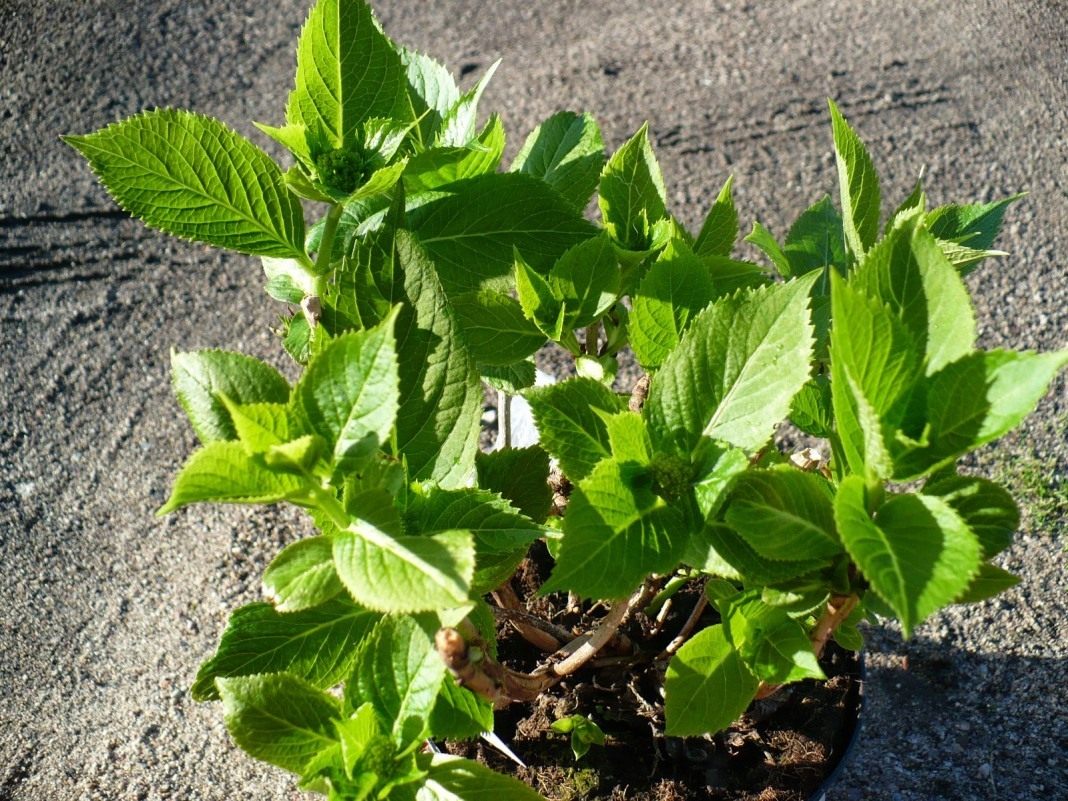
The soil needs fertile and a certain acidity so that the pH is about 5. In neutral soil, hydrangeas will also grow, but their flowering will not be so bright. As for the composition, any soil is suitable, except for sandy.
Pits for planting are prepared in advance, the holes are dug out small - 30-40 cm in diameter and the same depth. To increase fertility, the soil is mixed with humus, leafy soil and a small amount of superphosphate (40-50 g / well).
Landing technique
When planting several separate bushes, the distance between them should be at least 2.5 m. If a hedge is planted, then the plants can be placed at a distance of 1–1.5 m, but you need to be prepared for the fact that after a couple of years, frequent thinning will be required.
Technically, planting hydrangeas is no different from planting other ornamental shrubs:
- the seedling must be dug out with a clod of earth, and the broken roots, if any, must be cut;
- make a small mound in the middle of the landing pit;
- place the seedling so that the roots "look" down, and the root collar is at the level of the soil surface or slightly higher;
- cover with earth, slightly shaking the plant so that voids do not form;
- compact the ground around the seedling, water abundantly, cover with mulch if desired.
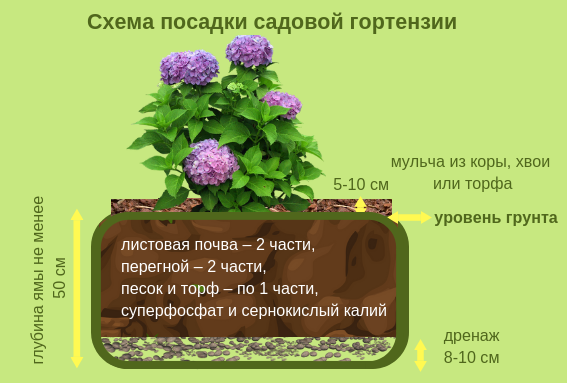
Rules for care and cultivation in the garden
If the bush is well looked after, it can grow and bloom for up to 40 years. Let's take a look at what caring for a plant includes.
Watering and feeding
Shrubs are quite moisture-loving, so you need to make sure that the soil under the bushes does not dry out. During the growing season, if there is no rainfall, watering is done once a week at the rate of 1.5–2 buckets per bush. Experienced gardeners are advised to sometimes use a weak solution of potassium permanganate for watering, which increases the strength of the shoots, or add a little citric acid to the water to brighten the inflorescences.
Hydrangeas are very responsive to feeding, decorativeness depends on their quantity. In the spring, at the beginning of the growing season, it is imperative to add a mineral complex with a nitrogen content. During the formation of buds, it is recommended to feed with phosphorus and potassium. Further, during the summer, you need to feed the bushes 2-3 times more with mineral fertilizers with microelements. The last feeding is carried out no later than the end of August, so that the plants have time to prepare for wintering.
Pruning
Mature shrubs need to be pruned every year. This is traditionally done in the fall, after flowering is complete. To add decorative effect, all the branches on the bush are cut into 3-4 buds. This removes damaged and small branches growing inside. Too old plants are cut out at the root - they grow back and renew themselves quite quickly. In the spring, only frozen shoots are removed. Throughout the season, you need to cut off the faded inflorescences.
The cut branches can be kept in Kornevin's solution and then planted in the ground. They take root quickly and as a result you will get new young bushes.
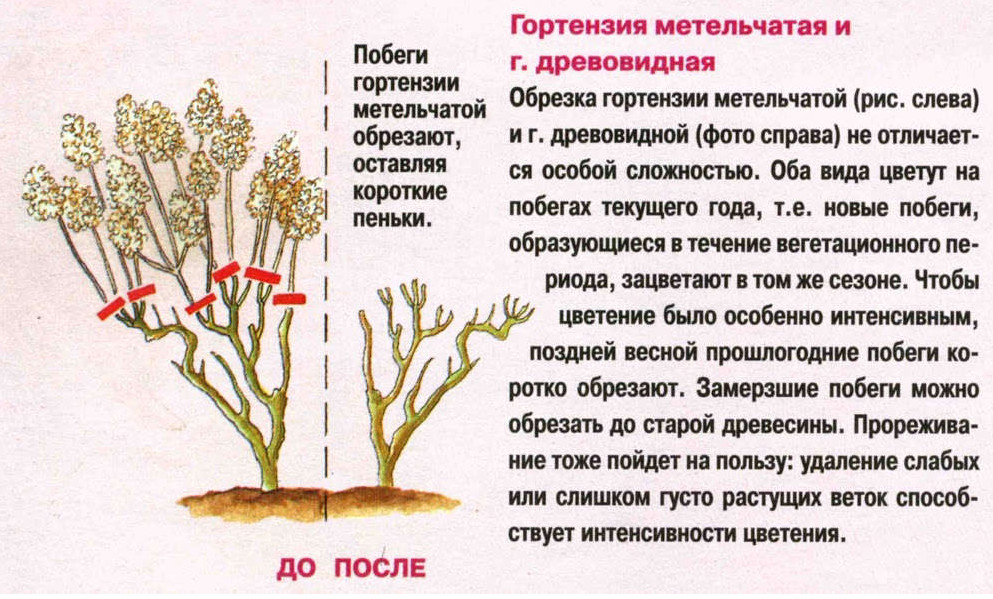
Loosening the soil and mulching
During the summer, it is imperative to carry out 2-3 weeding together with shallow loosening of the trunk circle. To keep the soil moist longer, not to overheat, and also for decorative purposes, the area around the bush is mulched. Sawdust, wood chips are suitable as mulch for hydrangeas - this material looks aesthetically pleasing and increases the acidity of the soil, which has a beneficial effect on the development of plants. Renew the mulch every spring.
Preparing for winter
Hydrangea bushes are quite winter-hardy and do not need insulation in temperate climates. All that needs to be done before wintering is to remove the remaining inflorescences, tie the branches so that they do not break under the weight of the snow, and sprinkle the root collar with earth.
In cold regions, to protect the roots from freezing, it is recommended to mulch the soil around the bush with peat or humus. Dry leaves are also suitable as shelter, but first you need to make sure that they are not infected with fungus. In the same way, young bushes are covered in the first year, if they are planted in the fall.
Hydrangea Phantom in landscape design
The Phantom variety is distinguished by its incredible beauty of flowering, therefore it is very often used in landscaping sites. Lush flowering shrubs fit perfectly into any composition, they form hedges. These flowers are often found in parks, city gardens and recreational areas.
Since plants are easily amenable to formative pruning, they can be used in a variety of ways in small summer cottages: for framing paths, as belt plantings when zoning space,in flower arrangements, mixborders. Hydrangeas look great as tapeworms against the backdrop of lawns and decorative greenery. The main thing is to provide the shrub with enough room to grow.
- Group landing
- Solitary landing
- Hedge
Reviews
“I recently discovered this hydrangea. It turned out that taking care of her is not difficult at all, it blooms very magnificently and smells divine. "
“I really like the scent of hydrangea. For several years we have been planted in the country, now we enjoy summer evenings. "
“This variety is growing recently. At first, the bush seemed too tall, but after pruning it looks gorgeous in the flowerbed. "
Due to its characteristics and high decorativeness, the variety has earned only positive reviews. Gardeners consider it the record holder in the line of paniculate hydrangeas and are most often planted on plots. The shrubs are very hardy, they are not afraid of frost, they go well with other flowers and bloom magnificently until autumn, transforming the design of the site.


